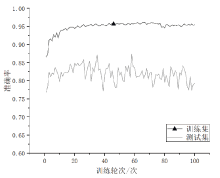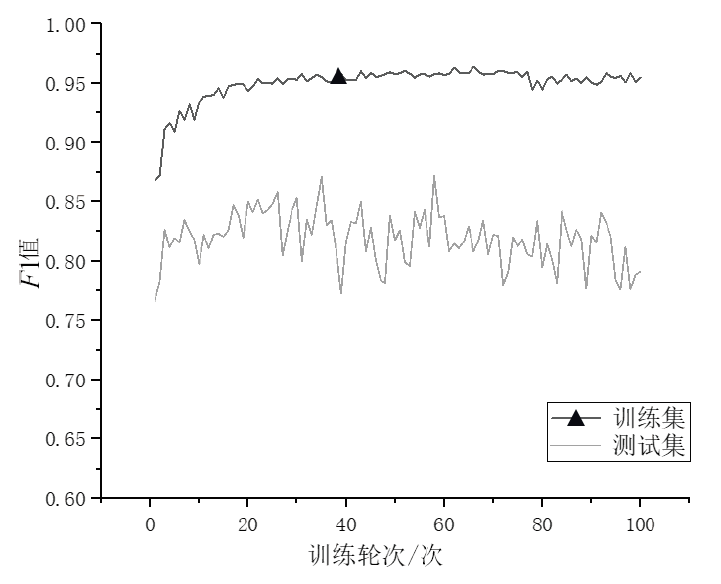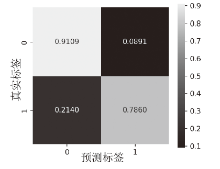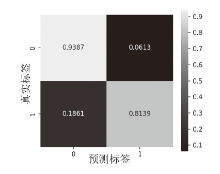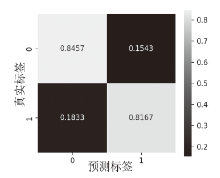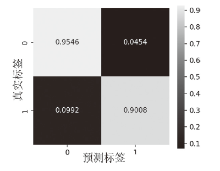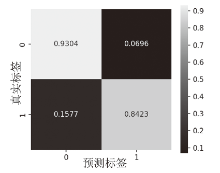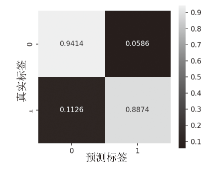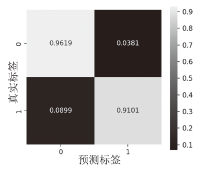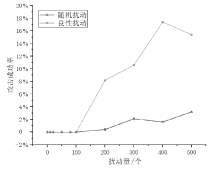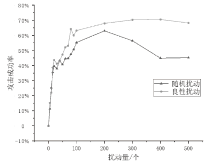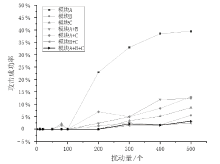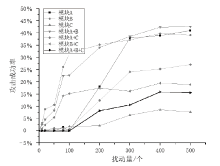Netinfo Security ›› 2025, Vol. 25 ›› Issue (1): 159-172.doi: 10.3969/j.issn.1671-1122.2025.01.014
Previous Articles Next Articles
A Dynamic Malware Detection Method Based on Ensemble Learning
LIU Qiang1,2, WANG Jian1, WANG Yanan1( ), WANG Shan3
), WANG Shan3
- 1. School of Air Defense and Antimissile, Air Force Engineering University, Xi’an 710051, China
2. Graduate School of Air Force Engineering University, Xi’an 710051, China
3. 94789 Troop of PLA, Nanjing 210018, China
-
Received:2024-09-25Online:2025-01-10Published:2025-02-14 -
Contact:WANG Yanan E-mail:wyn1988814@163.com
CLC Number:
Cite this article
LIU Qiang, WANG Jian, WANG Yanan, WANG Shan. A Dynamic Malware Detection Method Based on Ensemble Learning[J]. Netinfo Security, 2025, 25(1): 159-172.
share this article
Add to citation manager EndNote|Ris|BibTeX
URL: http://netinfo-security.org/EN/10.3969/j.issn.1671-1122.2025.01.014
| 训练集 | 测试集 | |||||||
|---|---|---|---|---|---|---|---|---|
| Accuracy | F1-值 | TPR(FPR=10-3) | AUC | Accuracy | F1-值 | TPR(FPR=10-3) | AUC | |
| 2-gram | 0.9592 | 0.9701 | 0.7962 | 0.9918 | 0.8432 | 0.8446 | 0.3879 | 0.9360 |
| 3-gram | 0.9515 | 0.9646 | 0.7616 | 0.9879 | 0.8334 | 0.8363 | 0.3806 | 0.9351 |
| 4-gram | 0.9348 | 0.9529 | 0.7207 | 0.9793 | 0.8317 | 0.8367 | 0.3856 | 0.9284 |
| 5-gram | 0.9159 | 0.9404 | 0.6827 | 0.9665 | 0.8261 | 0.8386 | 0.3694 | 0.9202 |
| [1] | Kaspersky Security Network. The Mobile Malware Threat Landscape in 2023[EB/OL]. (2024-02-06)[2024-09-10]. https://securelist.com/mobile-malware-report-2023/111964. |
| [2] | LI Sicong, WANG Jian, SONG Yafei, et al. Malicious Code Classification Method Based on BiTCN-DLP[J]. Netinfo Security, 2023, 23(11): 104-117. |
| 李思聪, 王坚, 宋亚飞, 等. 基于BiTCN-DLP的恶意代码分类方法[J]. 信息网络安全, 2023, 23(11):104-117. | |
| [3] | SUN Hongzhe, WANG Jian, WANG Peng, et al. Network Intrusion Detection Method Based on Attention-BiTCN[J]. Netinfo Security, 2024, 24(2): 309-318. |
| 孙红哲, 王坚, 王鹏, 等. 基于Attention-BiTCN的网络入侵检测方法[J]. 信息网络安全, 2024, 24(2): 309-318. | |
| [4] |
ZHANG Dandan, SONG Yafei, LIU Shu. MalMKNet: A Multi-Scale Convolutional Neural Network Used for Malware Classification[J]. Acta Electronica Sinica, 2023, 51(5): 1359-1369.
doi: 10.12263/DZXB.20221069 |
|
张丹丹, 宋亚飞, 刘曙. MalMKNet:一种用于恶意代码分类的多尺度卷积神经网络[J]. 电子学报, 2023, 51(5): 1359-1369.
doi: 10.12263/DZXB.20221069 |
|
| [5] | GALLORO N, POLINO M, CARMINATI M, et al. A Systematical and Longitudinal Study of Evasive Behaviors in Windows Malware[EB/OL]. (2021-12-05)[2024-09-10]. https://doi.org/10.1016/j.cose.2021.102550. |
| [6] | CHAI Yuhan. Research on Key Technologies for Malware Classification in Open World[D]. Guangzhou: Guangzhou University, 2023. |
| 柴瑜晗. 开放场景下恶意软件分类关键技术研究[D]. 广州: 广州大学, 2023. | |
| [7] | QIAO Yong, YANG Yueyang, JI Lin, et al. Analyzing Malware by Abstracting the Frequent Itemsets in API Call Sequences[C]// IEEE. 2013 12th IEEE International Conference on Trust, Security and Privacy in Computing and Communications. New York: IEEE, 2013: 265-270. |
| [8] | UPPAL D, SINHA R, MEHRA V, et al. Malware Detection and Classification Based on Extraction of API Sequences[C]// IEEE. 2014 International Conference on Advances in Computing, Communications and Informatics (ICACCI). New York: IEEE, 2014: 2337-2342. |
| [9] | ALAZAB M, ALAZAB M, SHALAGINOV A, et al. Intelligent Mobile Malware Detection Using Permission Requests and API Calls[J]. Future Generation Computer Systems, 2020, 107: 509-521. |
| [10] | KOLOSNJAJI B, ZARRAS A, WEBSTER G, et al. Deep Learning for Classification of Malware System Call Sequences[C]// Springer. Advances in Artificial Intelligence:29th Australasian Joint Conference (AI 2016). Heidelberg: Springer, 2016: 137-149. |
| [11] | AGRAWAL R, STOKES J W, MARINESCU M, et al. Neural Sequential Malware Detection with Parameters[C]// IEEE. 2018 IEEE International Conference on Acoustics, Speech and Signal Processing (ICASSP). New York: IEEE, 2018: 2656-2660. |
| [12] | ZHANG Zhaoqi, QI Panpan, WANG Wei. Dynamic Malware Analysis with Feature Engineering and Feature Learning[C]// AAAI. Proceedings of the AAAI Conference on Artificial Intelligence. New York: AAAI, 2020, 34(1): 1210-1217. |
| [13] | LI Ce, LYU Qiujian, LI Ning, et al. A Novel Deep Framework for Dynamic Malware Detection Based on API Sequence Intrinsic Features[EB/OL]. (2022-03-17)[2024-09-10]. https://doi.org/10.1016/j.cose.2022.102686. |
| [14] | ZHANG Sanfeng, WU Jiahao, ZHANG Mengzhe, et al. Dynamic Malware Analysis Based on API Sequence Semantic Fusion[EB/OL]. (2023-05-26)[2024-09-10]. https://doi.org/10.3390/app13116526. |
| [15] | DEMIRKIRAN F, ÇAYIR A, UNAL U, et al. An Ensemble of Pre-Trained Transformer Models for Imbalanced Multiclass Malware Classification[EB/OL]. (2022-08-06)[2024-09-10]. https://doi.org/10.1016/j.cose.2022.102846. |
| [16] | LI Yaping, LI Yuancheng. IoT Malware Threat Hunting Method Based on Improved Transformer[J]. International Journal of Network Security, 2023, 25(2): 267-276. |
| [17] | TRIZNA D, DEMETRIO L, BIGGIO B, et al. Nebula: Self-Attention for Dynamic Malware Analysis[J]. IEEE Transactions on Information Forensics and Security, 2024, 19: 6155-6167. |
| [18] | JIANG Haodi, TURKI T, WANG J T L. DLGraph: Malware Detection Using Deep Learning and Graph Embedding[C]// IEEE. 2018 17th IEEE International Conference on Machine Learning and Applications (ICMLA). New York: IEEE, 2018: 1029-1033. |
| [19] | AMER E, ZELINKA I. A Dynamic Windows Malware Detection and Prediction Method Based on Contextual Understanding of API Call Sequence[EB/OL]. (2020-02-20)[2024-09-10]. https://doi.org/10.1016/j.cose.2020.101760. |
| [20] | XIAO Fei, LIN Zhaowen, SUN Yi, et al. Malware Detection Based on Deep Learning of Behavior Graphs[EB/OL]. (2019-02-11)[2024-09-10]. https://doi.org/10.1155/2019/8195395. |
| [21] | LI Ce, CHENG Zijun, ZHU He, et al. DMalNet: Dynamic Malware Analysis Based on API Feature Engineering and Graph Learning[EB/OL]. (2022-08-21)[2024-09-10]. https://doi.org/10.1016/j.cose.2022.102872. |
| [22] | DONG Shishi, HUANG Zhexue. A Brief Theoretical Overview of Random Forests[J]. Journal of Integration Technology, 2013, 2(1): 1-7. |
| [23] | PARMAR A, KATARIYA R, PATEL V. A Review on Random Forest: An Ensemble Classifier[C]// Springer. International Conference on Intelligent Data Communication Technologies and Internet of Things (ICICI). Heidelberg: Springer, 2019: 758-763. |
| [24] | VASWANI A, SHAZEER N, PARMAR N, et al. Attention is All You Need[J]. Advances in Neural Information Processing Systems, 2017, 30: 5998-6008. |
| [25] | MIKOLOV T, CHEN Kai, CORRADO G, et al. Efficient Estimation of Word Representations in Vector Space[EB/OL]. (2013-09-07)[2024-09-10]. https://arxiv.org/pdf/1301.3781. |
| [26] | XU Keyulu, HU Weihua, LESKOVEC J, et al. How Powerful are Graph Neural Networks?[EB/OL]. (2018-10-04)[2024-09-10]. https://arxiv.org/pdf/1810.00826.pdf. |
| [27] | TRIZNA D. Quo Vadis: Hybrid Machine Learning Meta-Model Based on Contextual and Behavioral malware Representations[C]// ACM.Proceedings of the 15th ACM Workshop on Artificial Intelligence and Security. New York: ACM, 2022: 127-136. |
| [28] | MANDIANT. Speakeasy: Portable, Modular, Binary Emulator Designed to Emulate Windows Kernel and User Mode Malware[EB/OL]. (2021-10-11)[2024-09-10]. https://github.com/mandiant/speakeasy. |
| [29] | JINDAL C, SALLS C, AGHAKHANI H, et al. Neurlux: Dynamic Malware Analysis without Feature Engineering[C]// ACM. Proceedings of the 35th Annual Computer Security Applications Conference. New York: ACM, 2019: 444-455. |
| [30] | ROSENBERG I, SHABTAI A, ELOVICI Y, et al. Query-Efficient Black-Box Attack against Sequence-Based Malware Classifiers[C]// ACM.Proceedings of the 36th Annual Computer Security Applications Conference. New York: ACM, 2020: 611-626. |
| [31] | YU Lantao, ZHANG Weinan, WANG Jun, et al. Seqgan: Sequence Generative Adversarial Nets with Policy Gradient[EB/OL]. (2017-02-13)[2024-09-10]. https://doi.org/10.1609/aaai.v31i1.10804. |
| [32] | Cuckoo Sandbox. Cuckoo Sandbox Hooked APIs and Categories[EB/OL]. (2019-08-24)[2024-09-10]. https://github.com/cuckoosandbox/cuckoo/wiki/Hooked-APIs-and-Categories. |
| [1] | CHEN Xiaojing, TAO Yang, WU Baiqi, DIAO Yunfeng. Optimization Gradient Perception Adversarial Attack for Skeleton-Based Action Recognition [J]. Netinfo Security, 2024, 24(9): 1386-1395. |
| [2] | XU Ruzhi, ZHANG Ning, LI Min, LI Zixuan. Research on a High Robust Detection Model for Malicious Software [J]. Netinfo Security, 2024, 24(8): 1184-1195. |
| [3] | WANG Jian, CHEN Lin, WANG Kailun, LIU Jiqiang. Application Layer DDoS Detection Method Based on Spatio-Temporal Graph Neural Network [J]. Netinfo Security, 2024, 24(4): 509-519. |
| [4] | QI Han, WANG Jingtong, ABDULLAH Gani, GONG Changqing. Robustness of Variational Quantum Convolutional Neural Networks Based on Random Quantum Layers [J]. Netinfo Security, 2024, 24(3): 363-373. |
| [5] | ZHANG Xinyou, SUN Feng, FENG Li, XING Huanlai. Multi-View Representations for Fake News Detection [J]. Netinfo Security, 2024, 24(3): 438-448. |
| [6] | YU Shangrong, XIAO Jingbo, YIN Qilin, LU Wei. A Social Heterophily Focused Framework for Social Bot Detection [J]. Netinfo Security, 2024, 24(2): 319-327. |
| [7] | LI Yixuan, JIA Peng, FAN Ximing, CHEN Chen. Control Flow Transformation Based Adversarial Example Generation for Attacking Malware Detection GNN Model [J]. Netinfo Security, 2024, 24(12): 1896-1910. |
| [8] | ZHANG Xuan, WAN Liang, LUO Heng, YANG Yang. Automated Botnet Detection Method Based on Two-Stage Graph Learning [J]. Netinfo Security, 2024, 24(12): 1933-1947. |
| [9] | LU Xiaofeng, CHENG Tianze, LONG Chengnian. A Random Walk Based Black-Box Adversarial Attack against Graph Neural Network [J]. Netinfo Security, 2024, 24(10): 1570-1577. |
| [10] | XU Ke, LI Jiayi, JIANG Xinghao, SUN Tanfeng. A Video Gait Privacy Protection Algorithm Based on Sparse Adversarial Attack on Silhouette [J]. Netinfo Security, 2024, 24(1): 48-59. |
| [11] | QIN Zhongyuan, MA Nan, YU Yacong, CHEN Liquan. Network Anomaly Detection Based on Dual Graph Convolutional Network and Autoencoders [J]. Netinfo Security, 2023, 23(9): 1-11. |
| [12] | WANG Yu, LYU Liangshuang, XIA Chunhe. A Windows Malware Detection Method Based on Semantic Analysis [J]. Netinfo Security, 2023, 23(10): 58-63. |
| [13] | ZHENG Yaohao, WANG Liming, YANG Jing. A Defense Method against Adversarial Attacks Based on Neural Architecture Search [J]. Netinfo Security, 2022, 22(3): 70-77. |
| [14] | TONG Xin, JIN Bo, WANG Jingya, YANG Ying. A Multi-View and Multi-Task Learning Detection Method for Android Malware [J]. Netinfo Security, 2022, 22(10): 1-7. |
| [15] | ZHU Lina, MA Mingrui, ZHU Dongzhao. Detection Method for C Language Family Based on Graph Neural Network and Generic Vulnerability Analysis Framework [J]. Netinfo Security, 2022, 22(10): 59-68. |
| Viewed | ||||||
|
Full text |
|
|||||
|
Abstract |
|
|||||


















